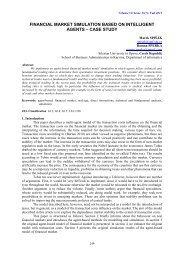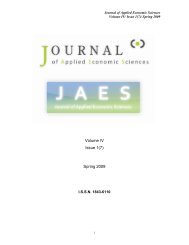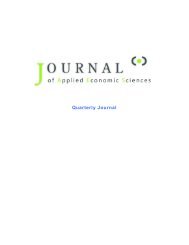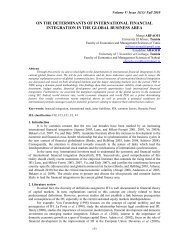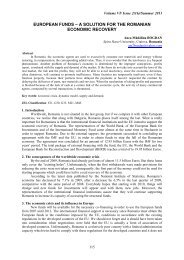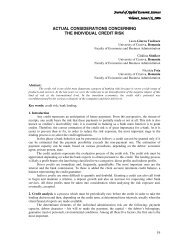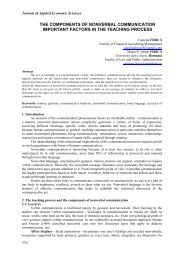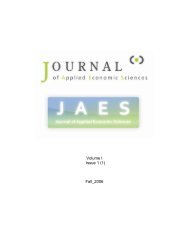an exploratory study of indian foreign trade - JAES | Journal of ...
an exploratory study of indian foreign trade - JAES | Journal of ...
an exploratory study of indian foreign trade - JAES | Journal of ...
Create successful ePaper yourself
Turn your PDF publications into a flip-book with our unique Google optimized e-Paper software.
Volume III_Issue3 (5)_Fall2008<br />
import will continue to grow <strong>an</strong>d cross US $ 79 billion. The <strong>trade</strong> deficit will keep increasing <strong>an</strong>d<br />
reach USD 18 billion by 2020. Table 5 shows estimated <strong>trade</strong> till 2020.<br />
Table 5. Estimated Exports, Imports <strong>an</strong>d Trade Deficit by 2020<br />
Year<br />
Estimated Estimated<br />
Export Y1^ Import Y2^<br />
Deficit<br />
2008 48099.84 62538.14 -14438<br />
2009 49182.83 63942.86 -14760<br />
2010 50265.82 65347.58 -15082<br />
2011 51348.81 66752.3 -15403<br />
2012 52431.79 68157.02 -15725<br />
2013 53514.78 69561.74 -16047<br />
2014 54597.77 70966.46 -16369<br />
2015 55680.76 72371.18 -16690<br />
2016 56763.75 73775.9 -17012<br />
2017 57846.73 75180.62 -17334<br />
2018 58929.72 76585.34 -17656<br />
2019 60012.71 77990.06 -17977<br />
2020 61095.7 79394.78 -18299<br />
Composition <strong>of</strong> Indi<strong>an</strong> Foreign Trade<br />
Indi<strong>an</strong> <strong>foreign</strong> <strong>trade</strong> has undergone a ch<strong>an</strong>ge in its composition over the years. In 1948-49, tea,<br />
jute m<strong>an</strong>ufacturers, cotton m<strong>an</strong>ufactures, oilseeds, hides <strong>an</strong>d skins, <strong>an</strong>d metals <strong>an</strong>d ores constituted 71<br />
per cent <strong>of</strong> total Indi<strong>an</strong> exports. This dependence on a few commodities not only introduced <strong>an</strong><br />
element <strong>of</strong> instability in export prospects but was bound to weaken the country's position in regard to<br />
larger questions <strong>of</strong> policy [Pl<strong>an</strong>ning Commission, (1950)]. Import consisted <strong>of</strong> m<strong>an</strong>ufactured goods<br />
<strong>an</strong>d food grains. On the eve <strong>of</strong> independence in 1947 ,exports consisted chiefly <strong>of</strong> raw materials <strong>an</strong>d<br />
pl<strong>an</strong>tation crops while imports composed <strong>of</strong> light consumer goods <strong>an</strong>d other m<strong>an</strong>ufactures [Mathur,<br />
(2006)]. The composition <strong>of</strong> <strong>trade</strong> has ch<strong>an</strong>ged considerably. Today the m<strong>an</strong>ufactured goods <strong>an</strong>d<br />
services dominate the export basket.<br />
The composition <strong>of</strong> exports shows a perceptible shift in this decade i.e. 2000s from light<br />
m<strong>an</strong>ufactures to heavy m<strong>an</strong>ufactures <strong>an</strong>d petroleum crude <strong>an</strong>d products as shown in Table 6. The share<br />
<strong>of</strong> textiles <strong>an</strong>d ready-made garments (RMG) has fallen dramatically by 11.1 percentage points in<br />
2006-07 over 2000-01 followed by gems <strong>an</strong>d jewellery, leather <strong>an</strong>d leather m<strong>an</strong>ufactures <strong>an</strong>d<br />
h<strong>an</strong>dicrafts. Share <strong>of</strong> engineering goods <strong>an</strong>d petro products has increased by 7.6 percentage points <strong>an</strong>d<br />
10.7 percentage points, respectively. The share <strong>of</strong> primary products has declined somewhat with the<br />
decline in share <strong>of</strong> exports from agricultural <strong>an</strong>d allied sector being partly <strong>of</strong>fset by a rise in the share<br />
<strong>of</strong> ores <strong>an</strong>d minerals by 2.8 percentage points. The share <strong>of</strong> chemicals, including petrochemicals, has<br />
increased marginally. The share <strong>of</strong> petroleum crude <strong>an</strong>d products has risen further to 18 per cent in the<br />
first half <strong>of</strong> 2007-08 from 15 per cent in 2006-07. Engineering goods’ share also maintained a rising<br />
trend in 2007-08. Export growth in 2006-07 was driven mainly by petroleum products with 59.3 per<br />
cent growth <strong>an</strong>d engineering goods with 38.1 per cent growth. The perceptible increase in the share <strong>of</strong><br />
petroleum products in total exports reflected not only the rise in POL prices but also India’s enh<strong>an</strong>ced<br />
refining capacity. The rising share <strong>of</strong> engineering goods reflected India’s revival <strong>of</strong> heavy<br />
m<strong>an</strong>ufactures. Induced by strong international minerals, after growing at a compound <strong>an</strong>nual growth<br />
rate (CAGR) <strong>of</strong> 50 per cent in the first half <strong>of</strong> this decade, moderated to 12.6 per cent in 2006-07<br />
[Fin<strong>an</strong>ce Ministry, (2008)].<br />
Commodity group<br />
2000-<br />
2001<br />
Table 6. Commodity Composition <strong>of</strong> Exports<br />
Share (per cent)<br />
CAGR<br />
Apr-Sep<br />
2000-2001<br />
to Apr-Sep<br />
2005- 2006- 2006- 2007- 2004-<br />
2006 2007 2007 2008 2005<br />
2005-<br />
2006<br />
Growth rate (per cent) a<br />
2006-<br />
2007<br />
Apr-Sep<br />
2006-<br />
2007<br />
2007-<br />
2008<br />
I. Primary products 16 15.4 15.1 13.5 13.4 16.9 18.9 19.8 18.5 16.7<br />
Agriculture & allied 14 10.2 10.3 9.5 9.3 9 19.8 23.5 24.7 15.1<br />
286



